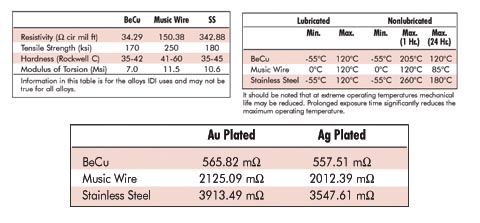Material Knowledge
Material Knowledge

Spring Materials and Platings
IDI uses three types of materials for springs: beryllium copper, music wire and stainless steel. Each of these materials has unique characteristics. Beryllium copper can operate at up to 205°C for 1 hour and has low resistivity and strength, thus, higher force springs can not be manufactured from beryllium copper. Music wire is used for high force springs as it has a reasonable resistance, but cannot operate at temperatures above 120°C. Stainless steel has the highest operating temperature (260°C for 1 hour), the highest resistance, and a strength between that of the other two materials.
The Spring Manufacturers Institute, Inc. is an organization in the United States and Canada which publishes a Handbook of Spring Design. The intent of this handbook is to use the organization’s technical expertise to establish high standards in spring design and manufacturing. The table below lists the critical properties of the three base materials used for springs.
Operating Temperatures of Spring Materials
The operating temperature range for Spring Contact Probes is dependent upon the spring material and lubrication. IDI selectively lubricates components of the Spring Contact Probes to increase mechanical life. The table below lists the temperature range for lubricated and nonlubricated probes.
Resistivity
A wire diameter of .0065″ with a length of 8.4″ is similar to a Size S-100 spring. To calculate the resistance of the spring, the following formula can be used.
As can be seen, the resistance of the spring is considerably higher than that of the typical plunger (1.26 milliohms) and barrel (8-10 milliohms). In actual use, the spring carries very little of the current. It is estimated that 99% of the current travels from the plunger to the barrel. The remaining current travels through the spring. On page 140, the total resistance of the Spring Contact Probe was theoretically calculated.
Tensile Strength and Modulus of Torsion
The tensile strength and the modulus of torsion (coefficient of stiffness) are critical in spring design. The higher the tensile strength and modulus of torsion, the higher the obtainable spring force.
Corrosion and Corrosion Resistance
Beryllium copper and music wire springs must have a protective coating to prevent corrosion. Stainless steel is primarily plated to reduce resistance.
Spring Platings
Springs are plated with either silver or gold. Silver has a high thermal and electrical conductivity. The intrinsic properties of gold prevent oxidation and corrosion. The same procedure as in the plunger section can be used to calculate the resistance of the individual layers: R1 = base material resistance, R2 = nickel barrier layer resistance and R3 = precious metal resistance. To calculate the resistance of a plated spring, Ohm’s Law for parallel resistors applies.
Substituting into the above formula, the resistance for the .0065″ diameter wire, 8.4″ long has the following resistances with gold and silver platings. IDI Springs are plated to the following military specifications: Gold—ASTM B-488-01 Nickel—ASTM B607, B656
